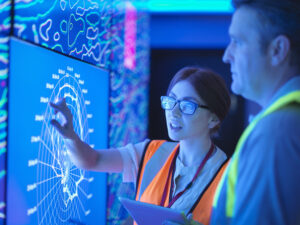The Process Digital Twin: A step toward operational excellence
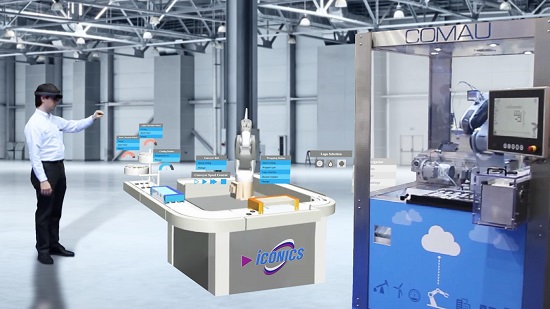 For the first time in many decades, we are at a point where technology innovation has outpaced business process innovation. If you think about it, it’s clear that digital transformation is not about software or technology. It is about innovating on business process improvement without being dependent on any technology constraints; technology only helps to accelerate the pace of transformation.
For the first time in many decades, we are at a point where technology innovation has outpaced business process innovation. If you think about it, it’s clear that digital transformation is not about software or technology. It is about innovating on business process improvement without being dependent on any technology constraints; technology only helps to accelerate the pace of transformation.
Key initiatives driving manufacturing transformation
At Microsoft, we see three clear drivers that are accelerating manufacturing transformation, today:
The design principles of Industry 4.0: This is about vertical integration, horizontal integration, and collaborative engineering all the way from supplier to manufacturer to customer. These principles call for achieving new levels of business value and process improvement across the network by taking advantage of new technology such as inexpensive connectivity, big compute and cloud.
The factory of the future: This is a virtual ecosystem where humans and machines work together like peers, and collaborative robots (cobots) are intelligent enough to contribute across an extended virtual ecosystem.
The Digital Twin: Key to the success of the factory of the future is the Digital Twin. While there are a wide variety of technologies at play in digital factories, three of them—artificial intelligence, IoT and mixed reality—are critical to truly achieving a new level of performance with a new class of Digital Twin.
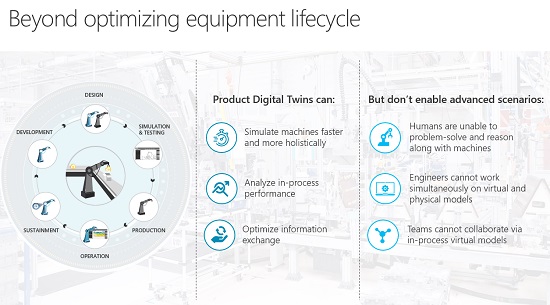 The evolution of the Digital Twin
The evolution of the Digital Twin
As we look back, we know that Digital Twins have evolved rapidly over the last two decades. For many years, the focus of creating a Digital Twin has been centered solely on equipment, most notably around optimizing the product life cycle.
However, there are limitations in terms of what traditional Digital Twins can achieve. For example, manufacturers can work on either the virtual model or the physical models but not on both simultaneously. Traditional systems severely limit the ability to collaborate across the virtual environment while in operation. And, while Digital Twins do extend predictive capabilities, as a stand-alone, they don’t support advanced reasoning alongside humans.
A new class of Digital Twin for Industry 4.0: The Process Digital Twin
Now we see a new evolution taking place. The power of the Digital Twin is no longer just around the visualization and collaboration of a specific piece of equipment to manage its lifecycle; we can now use the Digital Twin to understand the entire manufacturing operation – that is, create the Manufacturing Process Digital Twin.
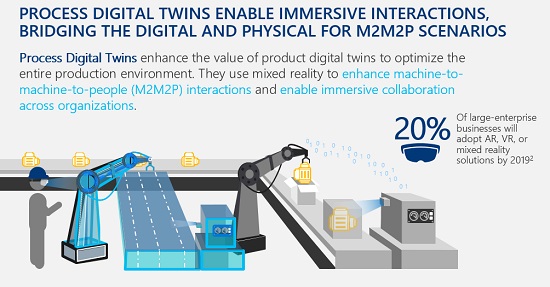 When you combine this kind of functionality, you can create an entirely new set of capabilities that improve the equipment performance and increase the quality of the end product—ultimately optimizing process improvements across the entire manufacturing process. This is what we can achieve with a new class of Digital Twin. Mixed-reality technology, with tools like Microsoft HoloLens, is what accelerates the pace of this innovation.
When you combine this kind of functionality, you can create an entirely new set of capabilities that improve the equipment performance and increase the quality of the end product—ultimately optimizing process improvements across the entire manufacturing process. This is what we can achieve with a new class of Digital Twin. Mixed-reality technology, with tools like Microsoft HoloLens, is what accelerates the pace of this innovation.
In a mixed-reality model, manufacturers can leverage immersive holograms to collaborate in virtual and physical models simultaneously. In these models you can represent an entire manufacturing system with each component having its own artificial intelligence, and all equipment is working in a true Machine-to-Machine-to-People (M2M2P) environment. This means you can use logic and reasoning during operations along with the manufacturing system, whether people are co-located or working from remote locations.
There are several benefits that make the Process Digital Twin such a valuable strategy to accelerate Industry 4.0. For example, you can better integrate internal operations in your organization and you can more easily collaborate across supply chains that are horizontally integrated in the hologram. In addition, product engineers in one organization can now interact with manufacturing engineers in another organization to not only improve the performance of equipment but also improve the quality of production, hence, creating a more efficient manufacturing operation.
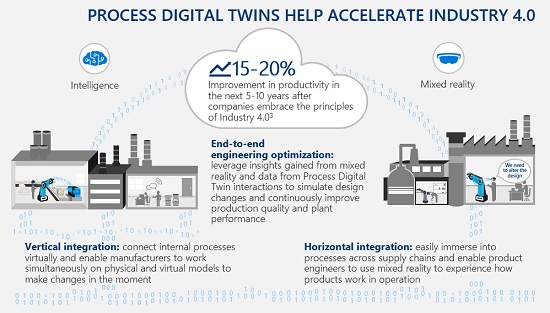 With the Process Digital Twin, you now have the ability to create new customer and enterprise value through personalized service, to drive product quality and advancements, to prevent breakdowns before they occur, and to reinvent knowledge-sharing in a people-machine environment. To ensure success, this Process Digital Twin must be intelligent, collaborative, interactive and contextual.
With the Process Digital Twin, you now have the ability to create new customer and enterprise value through personalized service, to drive product quality and advancements, to prevent breakdowns before they occur, and to reinvent knowledge-sharing in a people-machine environment. To ensure success, this Process Digital Twin must be intelligent, collaborative, interactive and contextual.
We have already started seeing showcases and implementations of the Process Digital Twin. At Hannover Messe 2017, we showed how leading manufacturers including Comau and ICONICS, as well as Tetra Pak and others, are already mastering operational and manufacturing excellence and driving process improvements with a Process Digital Twin strategy.
One compelling use case is how Schneider Electric is using Digital Twins to capture relevant data throughout the entire production environment. Watch this on-demand session from Microsoft Envision to see this innovation in action. In our discussion, Schneider Electric’s Maurizio Galardo, Microsoft’s Simon Floyd, and I explore how the new class of Digital Twin is bringing the power of immersive, mixed-reality capabilities to achieve new levels of operational efficiencies and unlock innovative business models.
The time is now for you to differentiate by building strategies to master digital excellence—and Microsoft can help. I invite you to leverage the Process Digital Twin—and the rich data it provides—as part of this next frontier in your own manufacturing environment.
Go to our Digital Twin site, http://aka.ms/digitaltwin.




